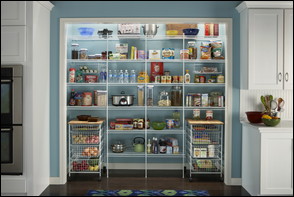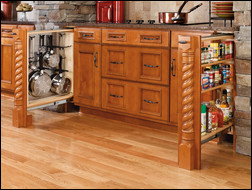Most people enjoy adding kitchen appliances, gadgets, dishware and silverware. Keeping these accumulated kitchen goodies organized and out of sight can quickly become challenging, if not downright
 ClosetMaid’s Close Mesh wire shelving is perfect for pantries. The deck wires are spaced 5/8 inches apart versus the 1 inch on the company’s other wire shelving. This "close mesh" wire shelving keeps small items in the pantry from tipping. Install with the ShelfTrack system and create a fully adjustable pantry. Photo courtesy of ClosetMaid. |
overwhelming. Fortunately, the kitchen storage industry has kept pace with the kitchen accessory industry. So, while there might be a limit to the storage space, there is no shortage of solutions to make the most of that space. These tips and products will help get any cluttered kitchen back on track.
Learn from the Pros
Homeowners looking to maximize kitchen storage can learn a lot from the professionals. Certified Kitchen Designers (CKDs) must address the kitchen storage issue when undertaking a kitchen renovation or remodel project. “I find out who the client is, first,” says Joan DesCombes, CKD, founder of Architectural Artworks, Inc., a design firm in Winter Park, Fla. Clients complete an extensive questionnaire which tells DesCombes about their lifestyle, which helps to determine the needs and solutions. “I want to know who does the cooking, what is being cooked [and] how many times a week shopping is done,” she says. “Once you know who the client is and what needs to be stored, you can determine how and where you are going to store it.”
A homeowner doesn’t necessarily need to hire a kitchen designer to make use of the same process used by professionals to solve the kitchen storage problem. Evaluating one’s own family size, cooking habits, shopping schedule and kitchen habits are great first steps to take before running out to purchase new-fangled kitchen cabinet pull-outs and organizers. “I make sure every item has a place,” says DesCombes. “That way, when the kitchen comes in and gets installed, I know exactly what gets stored where.” Homeowners can do the same thing by creating an inventory and storage plan not based on where things are stored now but based on where the homeowner wants them to be stored.
How the kitchen is used will greatly impact storage needs, which is why a hard look at family lifestyle and habits is a good place to start. In one recent project, DesCombes recalls a wife who couldn’t stand her husband’s newspapers scattered all over the counter and a husband who loved to read his papers in the kitchen. “I created a space specifically to house the newspapers,” says DesCombes. The storage-challenged homeowner should similarly take stock: In addition to cooking, what goes on in the kitchen? What items or materials must be stored in the kitchen for those activities? Who uses the kitchen—how often and for what purpose? Answering these questions will put the homeowner on the right track toward a more functional and better-organized kitchen. (Read more on kitchen planning here.)
Out with the Old
Part of revamping a kitchen’s storage capacity and configuration includes discarding items and gadgets that are no longer used. “Purging is what I always advise first,” says Elina Katsioula-Beall, CEO and chief designer for DeWitt Designer Kitchens of Studio City, Calif. “We all tend to accumulate more than we need. The first step is to let go of all that tired cookware, chipped dinnerware, worn-out plastic bowls and those hideous mugs. Keep only the good stuff and those timeless favorites, which can be enhanced with a few new basics.” This simple act of cleaning out undesirables will free up new space, open the door to fun storage products and bring the kitchen a little bit closer to a state of organization.
What Goes Where
With the kitchen activities and lifestyle in mind and an inventory in-hand, the homeowner needs to decide what gets stored where. Again, this decision can be largely based around usage of the kitchen. “I take the height of the clients into
 A Base Filler Organizer from Rev-a-Shelf makes the most of unused space. |
consideration, as well as who the primary cook is,” says DesCombes. If the primary cook in the kitchen is short, cookware like pots and pans will best be stored in a base cabinet. One product that would work well in this kitchen is available from Rev-a-Shelf, manufacturers of kitchen and bath organizing systems and accessories. “Our pot and pan organizer installs in the base cabinet and has a top shelf for lids and a bottom shelf for the pots and pans,” says Marketing Manager Shari McPeek.
Splitting up sets of dishware can make sense if certain items are best positioned in one particular spot, like near the prep sink. “Dishes stored in wall cabinets is certainly traditional, but it might only work for some dishes, and it’s not necessarily the best,” says DesCombes, who likes the adjustability and accessibility of a dish drawer. “Just move the pegs around to alter what pieces you want to put where.” Installing a dish drawer near or next to the dishwasher is one ergonomically advantageous storage solution, particularly for those challenged to reach the shelves of an upper cabinet. “There are different rules for glassware, dishes, canned food or cereal boxes, and they all have to do with their size and accessibility,” says Katsioula-Beall. “Instead of calculating abundance of shelving space, I opt for convenience and accessibility.”
The National Kitchen and Bath Association (NKBA) publishes an extensive list of guidelines that CKDs use to design a kitchen in a remodel or renovation. Some of these guidelines can be very helpful to the homeowner looking for answers to storage placement questions. Placement and orientation of the kitchen waste or recycling receptacles is one facet of kitchen storage planning that is addressed by the NKBA in a specific guideline. As a general rule, the trash bin should be placed within the “work triangle”— the area in the kitchen defined by the three main functioning positions: the sink, the stove and the refrigerator. Recycling might be another matter. “Recycling and waste can be very personal,” says DesCombes. “A two-sided, under-the-sink pull-out is fairly basic, although a lot of families don’t want their recycling in the main part of the kitchen.”
The end goal of a kitchen storage overhaul is to make life in the kitchen easier. Placement of utensils, cookware, dishware, the trash and the recycling should all serve that final goal.
Maximizing Space
Once the homeowner determines what needs to be stored where, the solutions may present themselves a little quicker. Even if the tightest of budgets rules out the option of creating additional cabinet space or carving out walls, there are myriad affordable organizing systems, pull-outs, door hangs and other accessories that will help find a space for all the accumulated items in a crowded kitchen.
“The Lazy Susan is one of our bestsellers,” says Rev-a-Shelf’s McPeek. The company offers that particularly product for blind corner, diagonal wall and base
cabinet configurations, and in full circle, kidney and D-shaped forms. “These days everyone has a Lazy Susan somewhere.” Pull-out organizing systems exist for base cabinets, drawers, blind corners and even “filler” sections of the cabinet system where a decorative cabinet face from three to nine inches wide might be hiding valuable and unused storage space.
“There’s about a hundred different ways you can configure the kitchen pantry,” says Steve Edling, founder and president of Shelves that Slide, a Phoenix, Ariz., company that began making pull-out shelves for the kitchen 18 years ago. In addition to their standard and bestselling pull-out sliding shelf organizers, Shelves that Slide manufacture and sell Lazy Susans, trash and recycling pull-out systems, drawer dividers and organizers, blind corner storage systems and custom-fit tip-out trays that can install just below the counter in front of the sink to store soak, sponges and scrubs. When it comes to accessorizing a kitchen with storage solution products, Edling advises homeowners to start small. “You can do a few products at a time,” he says. “If they work, you can install more.”
 Affordable pull-outs from Shelves that Slide. |
Kitchen storage products and kitchen organizing systems can range from the high-end adjustable storage systems like the “MulitMatic” by SieMatic—favored by designers like DesCombes—to the simple and more affordable options from companies like ClosetMaid, Lynk or simplehuman, available at big-box stores like Lowe’s and Target. By matching the inventory of items needing to be stored with the many storage solutions available, a homeowner will be taking a crucial next step toward a successful kitchen storage scenario.
Measurements
Properly measuring the available space is required for successful purchase and installation of any kitchen storage product or solution. “Customers tend to over-think the measuring part,” says Shelves that Slide’s Edling, whose company offers a handy measuring guide to help customers understand the process. The height and width of the cabinet as well as the cabinet depth opening must be taken. Mounting configurations for various slide-out or pull-out products will depend on the existing cabinet configuration—that is, if the existing cabinet contains a full-shelf, half-shelf or no shelf at all.
The Rev-A-Shelf Web site features a handy “Storage Planner” feature that makes measuring and product matching a breeze. Customers can enter cabinet type and dimensions to determine which available Rev-A-Shelf products will fit that specific opening.
Installation
A majority of the kitchen storage products and systems available to homeowners can be installed without the help of a professional. “If you can use a cordless screwdriver and a tape measure, you can install it,” says Edling. Most manufacturers and distributors of pull-out shelves and organizers include installation guides with their products, which often require little more than the fastening of a few brackets and screws. “I’ve had guys in New York City who swore they would never learn how to change a tire able to put together a pull-out in minutes,” he adds.
Lazy Susans can be the exception to the easy-DIY rule. These particular kitchen storage products come with templates and require a little more drilling, assembling and know-how to properly install. If a homeowner is in doubt about successfully installing a kitchen storage product, hiring a professional is the better way to go.
A clean and tidy kitchen adds value to life in the home. “Most working people manage to use their kitchen only in the morning for breakfast or when they fix dinner in the evening,” says Katsioula-Beall. “That also happens to be the only time we have to spend with loved ones, which we share by cooking or enjoying a meal. This, then, is precisely the time to avoid any stress or frustration that derives from poorly thought [out] kitchen storage.”
Whatever a kitchen’s storage needs, the solution is out there. Homeowners hiring a professional designer for a kitchen remodel should stay attentive to the storage aspect of the design process. “Form must always follow function,” insists DesCombes. Those looking for budget-friendly, self-install products would be wise to follow the planning process taken by the professionals before purchasing to ensure a functioning and organized kitchen space.
Credit: Renovate Your World




























